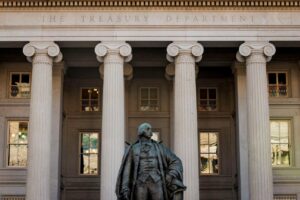Transformations Ahead: What the New U.S. Treasury Leadership Means for the Debt Market
The upcoming transition in leadership at the U.S. Treasury is poised to influence the department’s approach to managing its cash reserves held at the Federal Reserve. Financial strategists are cautioning that these changes could have significant ramifications for the nation’s debt market.
Major financial institutions like Bank of America and Wrightson ICAP are suggesting that the Treasury might reduce its cash reserves in light of dwindling balances. Currently, the Treasury maintains these reserves—a safety net to ensure the government can always meet its obligations—at the Fed. With the debt ceiling reinstated and cash reserves on the decline, this strategic move could enable the government to minimize its issuance of short-term debt, ultimately resulting in potential savings for taxpayers.
According to financial experts, including Wrightson ICAP Chief Economist Lou Crandall, the new Treasury team is likely to reassess recent years’ large cash reserve policies. Crandall suggests that lowering the cash balance to historic norms would not pose major operational risks for the government. Additionally, such a recalibration might delay any necessary adjustments to coupon-bearing debt auction sizes, allowing for more efficient management of finances amid existing economic pressures.
This discussion comes at a time when Scott Bessent, awaiting confirmation as head of the Treasury, has expressed concerns over the reliance on short-term debt to fund the deficit. Bessent argues that this approach has kept long-term rates artificially low, a notion that was firmly denied by the previous Treasury administration under Janet Yellen.
As the Treasury prepares for its quarterly debt refunding next month, market analysts are closely monitoring whether Bessent will announce intentions to dial back cash reserve targets. Current data shows the cash balance in the Treasury General Account at the Fed has dropped to $665 billion as of January 22, down from a peak of $962 billion in April. Last year’s average sat around $748 billion, indicating a trend of diminishing reserves.
Historically, the Treasury adopted a policy in 2015 to maintain a minimum of $150 billion—equivalent to five days’ worth of expenditures—in the account, up from just two days’ worth. This increase was largely a response to escalating budget deficits, which have seen total U.S. Treasury debt balloon to over $28 trillion from about $13 trillion just eight years ago.
Even minor adjustments to the cash balance could free up the Treasury to issue fewer bills, which might alleviate some upward pressure on interest rates. This could also provide the Federal Reserve with the necessary room to continue its quantitative tightening (QT) policies without the fear of excessive market fluctuations.
Currently, the Fed has reduced its holdings of government securities by over $2 trillion since it began unwinding its balance sheet in mid-2022. Recent reports suggest that Barclays and Bank of America have pushed back their forecasts for the conclusion of QT to September, citing low volatility in funding markets and a lack of clear communication from the Fed on future plans.
The reintroduction of the debt ceiling complicates the outlook for Treasury’s near-term debt issuance and the Fed’s unwinding process. Should this episode drag on, the government might be forced to curtail bill supply and deplete its cash reserves, creating further challenges in the liquidity markets.
Looking ahead, any resolution to the debt limit could trigger a rapid reversal in both the Treasury balance and bank reserves. However, a leaner government cash pile may minimize volatility in the Fed’s liabilities and provide a more steady environment for money-market rates.
In a context where past strategies are reevaluated, the Treasury’s approach to cash management may significantly impact fixed-income investors. According to strategists at Bank of America, this change means that the dynamics surrounding the U.S. Treasury cash balance are more unpredictable than ever. While the Treasury Borrowing Advisory Committee can offer recommendations and Congress maintains oversight, it remains the Treasury Secretary’s prerogative to influence cash policy—a decision that may come with substantial financial implications.
As the landscape evolves, it will be crucial for investors and analysts alike to at least keep one eye on Washington and the shifting policies at the Treasury that could redefine our financial environment in the months to come.

